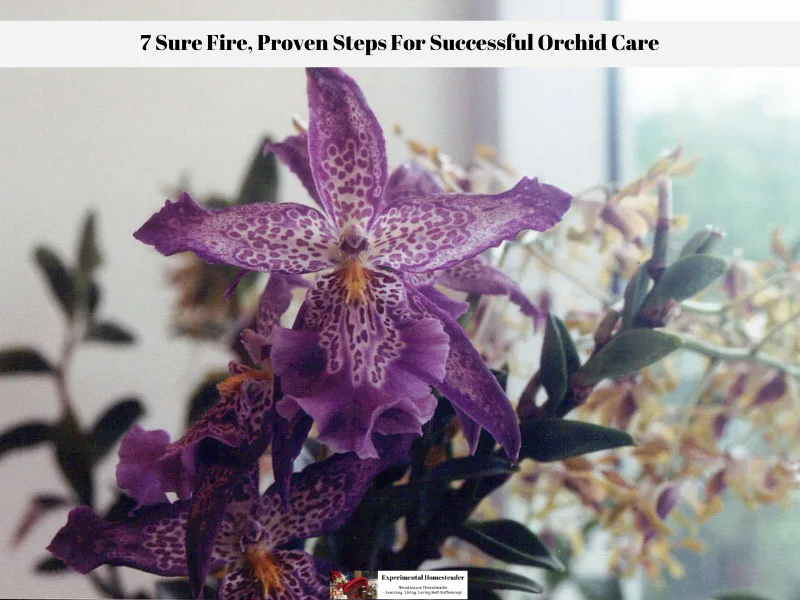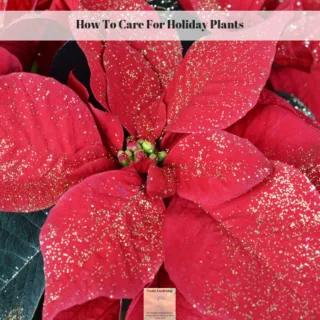Successful Orchid care is not hard if you understand the basic needs of this plant and provide them with what they need to thrive.
It’s no wonder that people fall in love with the beautiful, exotic looking flowers of the orchid family as the flowers are quite showy.
Orchid flowers come in a variety of colors, the plants themselves come in various sizes and they make great house plants.

Basics Of Successful Orchid Care
Unfortunately, caring for Orchids involves more than getting the plant, watering it and feeding it at regular intervals.
These plants - especially the Blue Orchid - are very in-demand, and most growers create a booming business selling them but often fail to provide adequate care tips with the plants.
Whether or not you’re new to this flowering plant, you can benefit from knowing how to get the healthiest flowers from your efforts.
Start With A Healthy Plant
You want to make sure that the plant you select will give you beautiful blooms which is why starting with a healthy plant is so important.
Some people buy very small Orchid plants in order to save money and then don’t understand why they don’t flower right away.
It can take years for a new plant to flower and thus what you want to do is select one that is in bloom.
This also helps to make sure the flowers on the plant you choose are ones you will like.
Some Orchids have fragrant flowers and some do not.
Choosing plants that are in bloom is the only way to know for sure if your Orchid is fragrant or not.
It is ok to buy ones on sale with faded flowers because while they may not flower again for a while, you know they are of blooming size.
Buy Plants With Healthy Leaves
If the leaves are pale or look spotted, then the plant isn’t healthy and it is best to not purchase it.
If you already have Orchids at home and the leaf color isn’t consistent, then something’s wrong with the plant.
Spotted leaves often mean the orchid has a virus and it is best to avoid buying Orchids with this problem.
Why A Virus Is Bad News
A virus can easily spread to your entire orchid collection and kill your plants.
In the event one of your Orchids gets a virus, be sure to separate it from your healthy plants right away.
Properly dispose of diseased plants and do not add them to your compost pile because the disease could continue to spread.
Proper Watering Is Important
Give your plant the water amount that’s suitable for the type of orchid that you have.
Give your Orchids plenty of water, especially in the hot summer months.
The moss and bark they grow in can dry up very quickly during hot weather.
Be sure to keep an eye on the roots to make sure you’re maintaining a healthy moisture level.
Healthy Orchid roots are plump and green, not brown, black or shriveled.
Shriveled roots that are white, brown or black are dead.
Carefully cut away all dead or damaged roots from the plant during the re-potting process.

Orchids Love Shady Spots Outside
When it’s nice outside, let the plant spend some time outdoors, but not under the direct glare of the sun.
Just like human skin, these plants can sustain a nasty sunburn and then the leaves don't look as nice.
But remember to bring them back indoors once the temperatures begin to drop.
I place my orchids in a spot that receives filtered morning sunlight and afternoon shade.
Another tip is use a hummingbird mister during the hot afternoon to offer extra humidity around the plants.
I make sure to bring them indoors once the temperature falls to 50 degrees Fahrenheit at night.
Fertilize Your Orchids On A Schedule
Be sure to feed your Orchids on a regular schedule per the instructions on the fertilizer you use.
You can use regular plant fertilizer for this, but be aware that many regular plant fertilizers contain salt, which isn’t good for your Orchids.
I use a fertilizer that is designed just for orchids.
This way my Orchids get the right amount of nitrogen, potassium and phosphorus they need to thrive.
Typically Orchids get a balanced amount of nitrogen, potassium and phosphorus.
Look for an Orchid fertilizer that says something like 20-20-20 on the label.
Repot Your Orchids As Needed
If you’re bringing home new Orchids, odds are that they’re in a pot that’s meant as a temporary home.
Don’t make the mistake of leaving them in the pot for too long, instead replant them with a mix that’s specifically made for your orchid.
Be sure to remove any dead roots or faded flowers during the repotting process.
Watch For Pests On Your Orchids
Keep an eye on your Orchids because they can get infected with pests.
Pests love to devour plants, draining them of their beauty - and in the case of a serious infestation, killing the plant completely.
There are special sprays you can buy and natural methods you can use to treat your Orchid, killing any infestations and keeping new ones at bay.
The key is to catch the pests right away before your plant is completely infested and reaches the point of no return.
Results Of Successful Orchid Care
By taking the time to properly care for your Orchids, they will yield a crop of flowers that you can enjoy over and over again.
Orchid flowers also last quite a while each time they flower.
They will continue to reward you with additional bloom spikes as long as they are happy.
Don’t let the thought of the kind of care they need overwhelm you because let's face it, all plants need proper care to thrive.
Once you get the hang of successfully growing orchids and getting them to rebloom, you’ll be glad that this was the flower you chose to grow in your home.
Flowering Tropical Plants
How To Grow Tacca To Be A Successful Bloomer
The black flowers intrigued me, but the bat plant comes in many colors - brown, white and even green! Learn how to grow tacca from seed to bloom!
Amorphophallus Titanium: Life Cycle And Facts About The Corpse Flower
Learn about the life cycle of the Amorphophallus titanium as well as how to propagate it and some fun facts about this unique corpse flower.
Introducing Brugmansia: A Superior, Fragrant, Nocturnal Plant
Brugmansia trees are highly fragrant, night blooming plants with trumpet shaped flowers. Learn how to care for your brugmansia.
How To Care For Holiday Plants
Have you ever wondered how to care for holiday plants such as the Poinsettia or the Christmas Cactus? If so, then check out this holiday plant care guide
Zantedeschia aethiopica Green Goddess
Learn how easy it is to grow Zantedeschia althiopica Green Goddess from seed by using the damp paper towel method plus seed to bloom time.
How To Grow Heliconia
Learn how to grow Heliconia. Proper plant care is important to keeping your Heliconia healthy and thriving.
Plumeria: The Lei Flower Is A Fragrant, Easy To Grow Houseplant
Learn how to care for your Plumeria in ground and in containers. Because of the winter dormancy period it is ideal for summer containers.
Growing Tropical Plants
The key to successfully growing tropical plants is learning about them. Growing tropical plants is easy once you know their basic needs.
How To Grow Enormous Tropical Bulbs In Containers
Learn how to successfully grow tropical bulbs in containers. Regardless of where you live, there are reasons to grow in containers.
Easy Exotic Houseplants: Tropicals That Thrive Indoors in Containers
Tropical plants are the most beautiful, easy to grow indoor houseplants. Start growing exotic houseplants today that fruit and flower!
Coral Vine (Antigonon leptopus): A Beautiful Yet Invasive Climbing Vine
Explore the allure and challenges of Antigonon leptopus, a captivating climbing vine, and its impact on local ecosystems.
Suggested Reading: Two Great Books On Tropical Ornamentals
Learn about two books on tropical ornamentals. Breeding Ornamental Plants and Tropical Ornamentals are a must read for those who love plants.
How To Grow Beautiful, Delicate Tibouchina
Tibouchina are beautiful but delicate plants with gorgeous purple flowers and a velvet like foliage. They can be bushes or vines.
How To Grow Mallows
Learn how to grow mallows, a Malvaceae family which includes some of the most popular plants for the home garden, Hibiscus.
Ophrys
Ophrys are a rare group of terrestrial Orchids that grow in the wild and look like insects, especially bees, hence their common name.
Flowering Trees For Fragrance And Beauty
Flowering trees add beauty and fragrance to the garden. There are ones for tropical climates, cold climates and even indoor gardens.
Expert Advice On How To Grow Beautiful Allamandas
Allamandas come in a range of colors, are easy to grow and do well in containers. They also overwinter well indoors in cold climates.
Expert Advice On How To Grow Oleanders
Learn how to grow Oleanders as well as propagation methods. Learn about the toxicity of this plant as well.
Rafflesia Arnoldii
Rafflesia arnoldii produces the largest flower in the world yet this colorful, but strange plant is rare and grows on the rainforest floor.
Tropical Plants In Cold Climates: Overwinter Tropical Plants Or Start Over Each Year From Seed
Tropical plants grown in cold climates look great during the summer outside but many make great houseplants in the winter.
Celebrate Halloween With Night Blooming Plants
A cool way to decorate and celebrate Halloween is with night blooming plants! Create a spooky garden that glows in the dark this year!
How To Grow Tropical Plants
Growing tropical plants - also known as houseplants - indoors is fun and enjoyable plus many of them clean the indoor of pollutants.
It is easy to grow exotic looking plants that produce tropical fruit and colorful flowers in a pot in your living room or office.
Many of these plants are easy to start from seed and I share with you five plants that I recommend for indoor growing.
I also share with you why growing your own tropical fruit saves money.
In this video you will learn:
How to bring tropical plants indoors at the end of summer
How to grow tropical plants indoors
How to protect and overwinter tropical plants outdoors in cold climates
How to propagate tropical plants
How to water tropcial plants
How to grow topical plants in a greenhouse




























